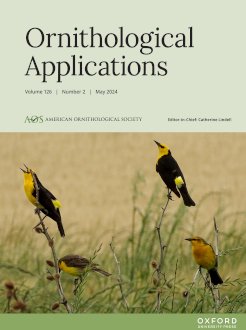Climate change, management legacies, pest outbreaks, and fire regimes are combining to pose a growing risk of broad-scale loss of forest cover throughout western North America. Already, habitat changes have been linked with declines in numerous bird species; understanding the relative importance of management regimes and habitat structure may be critical to conserving at-risk species. The Olive-sided Flycatcher (Contopus cooperi) is a declining songbird associated with tall, open forests in California's Sierra Nevada, the core of its breeding range, where the management regimes of the National Park Service (NPS) and U.S. Forest Service (USFS) have led to divergent forest conditions over the past century. We combined a landscape-scale passive acoustic monitoring program, the BirdNET animal sound identification algorithm, and single-season occupancy models to explore the relationships between Olive-sided Flycatchers in the Sierra Nevada and both management regimes and fine-scale forest structure. Olive-sided Flycatcher site occupancy increased as canopy cover decreased relative to mean tree diameter, which is consistent with their preference for mature, open forests. These “open forest” conditions were most prevalent on NPS-managed lands, which is consistent with the assumption that the NPS management regime is more faithful to the historical conditions that had supported a larger Olive-sided Flycatcher population than at present. Thus, the support we found for a positive association with USFS-managed lands after controlling for “open forest” suggests that other habitat features are also important. Our results suggest that conservation strategies for Olive-sided Flycatcher breeding habitat should prioritize the protection and generation of open canopies in areas with large trees, as well as the identification of other important habitat features. Prescribed fire, mechanical thinning, and a return of Indigenous forest management practices could help to restore historical forest and fire conditions beneficial to this and other species with similar habitat requirements. Fine-scale alterations to forest structure can be implemented much more rapidly and at much broader scales than the imposition of strict protected status, suggesting that there may be multiple pathways to conservation when species respond to habitat at fine spatial scales.
LAY SUMMARY
Fires are burning larger and hotter in forests across western North America, which poses a threat to forests and the wildlife that rely on them. One such species is the Olive-sided Flycatcher, which has declined by over 78% in the last 50 yr and is on pace to lose another 50% in coming decades.
The Sierra Nevada in California is the core of the flycatcher's range, and differing management regimes implemented by the National Park Service and the U.S. Forest Service have led to different forest conditions, which may systematically benefit this species.
We used passive acoustic surveys to collect thousands of hours of audio in both jurisdictions and identified Olive-sided Flycatcher songs with an artificial intelligence tool.
We found that differences in forest structure at the scale of several hundred meters were more important in determining where the flycatcher was found than the management regime (Park Service or Forest Service).
Olive-sided Flycatchers prefer forests that are relatively open yet contain relatively large-diameter (older) trees. Protecting and creating this type of habitat could help stop or even reverse declines in this species.
El cambio climático, las herencias de manejo, los brotes de plagas y los regímenes de incendios se están combinando para plantear un creciente riesgo de pérdida a gran escala de la cobertura forestal en el oeste de América del Norte. Los cambios en el hábitat ya han sido vinculados con el declive de numerosas especies de aves; comprender la importancia relativa de los regímenes de manejo y de la estructura del hábitat puede ser crucial para la conservación de especies en riesgo. Contopus cooperi es un ave canora en declive asociada con bosques altos y abiertos en la Sierra Nevada de California, el núcleo de su área de reproducción, donde los regímenes de manejo del Servicio de Parques Nacionales (NPS por sus siglas en inglés) y del Servicio Forestal de los EEUU (USFS por sus siglas en inglés) han llevado a condiciones forestales divergentes en el último siglo. Combinamos un programa de monitoreo acústico pasivo a escala de paisaje, el algoritmo de identificación de sonidos de animales de BirdNET y modelos de ocupación de una sola temporada para explorar las relaciones entre C. cooperi en la Sierra Nevada y el régimen de manejo por un lado y la estructura fina del bosque por el otro. La ocupación del sitio por parte de C. cooperi aumentó a medida que la cobertura del dosel disminuyó en relación con el diámetro medio del árbol, lo cual es consistente con su preferencia por bosques maduros y abiertos. Estas condiciones de “bosque abierto” fueron más prevalentes en tierras manejadas por el NPS, lo cual es consistente con la suposición de que el régimen de manejo del NPS es más fiel a las condiciones históricas que habían mantenido una población más grande de C. cooperi en el pasado que en la actualidad. Así, el respaldo que encontramos para una asociación positiva con las tierras manejadas por el USFS después de controlar por el “bosque abierto” sugiere que otras características del hábitat también son importantes. Nuestros resultados sugieren que las estrategias de conservación del hábitat reproductivo de C. cooperi deben priorizar la protección y generación de dosel abierto en áreas con árboles grandes, así como la identificación de otras características importantes del hábitat. El fuego prescrito, la reducción mecánica de la densidad y el retorno de prácticas de manejo forestal Indígenas podrían ayudar a restaurar las condiciones históricas del bosque y del fuego beneficiosas para esta y otras especies con requisitos de hábitat similares. Las alteraciones a pequeña escala en la estructura del bosque se pueden implementar mucho más rápidamente y a escalas mucho más amplias que la imposición de un estricto estatus de protección, lo que sugiere que pueden haber múltiples vías para la conservación cuando las especies responden al hábitat a escalas espaciales pequeñas.






